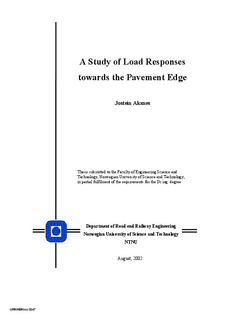| dc.description.abstract | A major part of the national and county road network in Norway consists of two-lane roads with relatively narrow shoulders. The width of the roadway is limited, forcing heavy trucks to drive close to the pavement edge. This represents a considerable deteriorating effect on these pavements, which typically consist of granular base materials and thin asphalt surfacing. The result is often premature cracking and deformations along the pavement edge.
Despite the fact that pavement edge damages represent a great problem for the Norwegian road network, little research has been performed on this topic. This is the main background for the present thesis work to focus on pavement edge damages and load responses towards the pavement edge.
Chapter 2 gives a brief presentation of the basic theory of continuum mechanics together with some elastic constitutive material models. The general elasto-plastic theory is also described. Further, methods and programs based on elastic layer theory developed for structural analysis of pavements are presented. Finally, advantages and basic principles for the finite element method are discussed.
In Chapter 3 the different types of pavement edge damages are described. Further, the factors influencing the strength of the pavement edge and damage development are discussed. To get information of the variation of bearing capacity over the cross section of existing roads, own FWD measurements are performed at different sites in Sør-Trøndelag county. As expected, a considerable decrease in bearing capacity towards the pavement edge was found. Also a minor field study on the effect of varying side slope is accomplished. The structural effect of gradually steepening the side slope is measured by FWD and plate loading tests. Chapter 3 also contains the findings from a literature review on measurement and calculation of pavement edge effects. Only a small number of articles on these subjects were found.
A full-scale pavement test has been performed at Sandmoen near Trondheim. Two pavements with different subbase materials were constructed, one of them instrumented for the measurement of stresses and strains in the base and subbase layers at different offsets from the pavement edge. The construction work, materials, sensor types and positions are thoroughly described in Chapter 4.
Results from Sandmoen test field are presented in Chapter 5. Responses to three different types of loading have been measured. These are controlled wheel loading, FWD and plate loading. Vertical stresses have been successfully measured at the bottom of both the base and the subbase layers. Independent of loading type, the results show increasing vertical stresses as loads are applied closer to the pavement edge. This effect is evident at the bottom of the base layer for load positions closer than approximately one meter from the edge. Increasing horizontal stress is recorded at the bottom of the base layer when a load is applied on the pavement surface. Deformation measurements show large plastic strains in granular materials, especially for load application close to the pavement edge. Parts of these strains recover when the load position is changed.
Theoretical modelling and analysis of the Sandmoen test field are dealt with in Chapter 6. Both multilayered elastic and three dimensional finite element analyses are performed. In all calculations, the load is modelled as a uniformly distributed vertical pressure over a circular area, and all materials are modelled as linear elastic with material parameters found from laboratory testing. When linear elastic material models are used, the three dimensional finite element calculations show only insignificant differences in stresses, strains and deformations as the load is moved towards the pavement edge. Best correlation between measured and calculated load responses are found for vertical stress and strain in the base layer for the case of static plate loading being applied in the inner wheel path. Beyond this, the comparisons of measured and calculated load responses show considerable discrepancies. | nb_NO |
